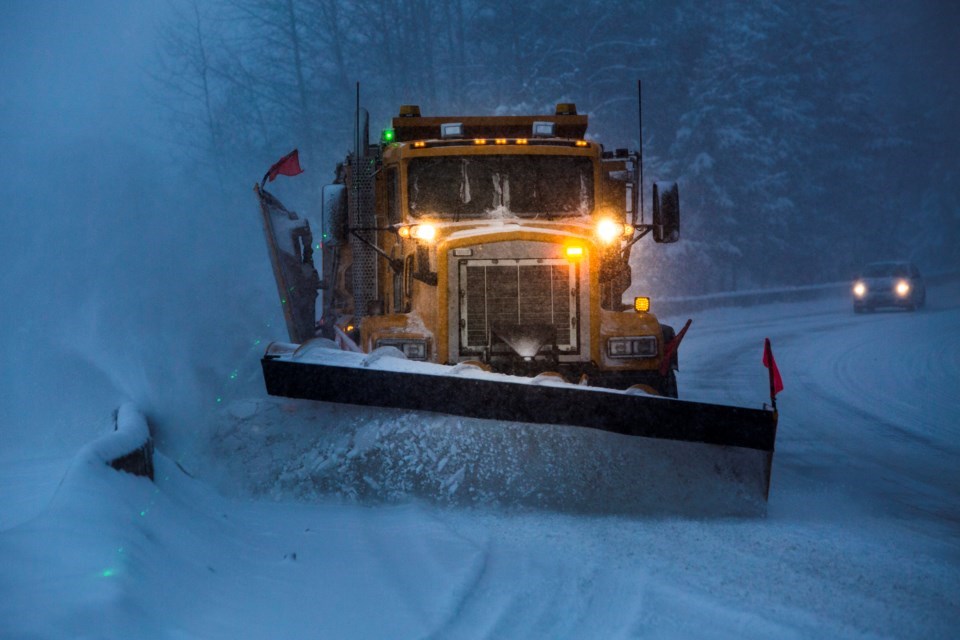The skies might have been clear during Whistler’s last regular council meeting on Tuesday, Jan. 25, but mayor and council had their attention focused on stormier weather.
The RMOW’s manager of transportation and waste management Andrew Tucker was on hand to provide an update regarding Whistler’s municipal road maintenance program, offering some insight into how staff deal with snowy roads and the resulting issues many motorists experienced during the resort’s busy holiday period.
Though the main route through town, Highway 99, is managed by the province’s Ministry of Transportation and Infrastructure (MOTI) and contractor Miller Capilano, as Tucker explained, RMOW staff is tasked with maintaining the community’s neighbourhood roads.
Staff begins by assessing weather forecasts and planning accordingly, before heading out when temperatures drop to treat roads with calcium chloride—a liquid that adjusts roads’ freezing temperatures. But once a storm passes through, crews “need to reset,” explained Tucker.
They get to work widening roads, pushing back snowbanks, opening up intersections and clearing storm drains. “Some neighbourhoods do not have a lot of snow storage, so we’ll go in, we’ll remove that snow and we’ll take it to another location,” Tucker said, “like Day Lot 5, for example.”
Tucker also acknowledged the heavy congestion that essentially gridlocked Whistler roads over the holiday period. “We had a series of weekends where we had heavy snow and big snowstorms, which is great for the mountain—a lot of people are excited—but it also occurs when it’s the busiest time of the week for Whistler,” he said.
More problems were posed by “a significant increase of the number of crashes” the resort saw over the holiday period compared to prior years, Tucker said, partly due to vehicles that were not properly equipped to be driving on snowy Whistler roads. Collisions “stop traffic and prevent the maintenance contractor from doing the work that they need to do to maintain that service level for the highway,” he said.
Afternoon congestion is not a new issue for the resort, Tucker added. “We know that the solution is [reducing] the number of vehicles that are travelling along the highway. But how do we do that?” he said.
The answer, Tucker explained, is to improve both regional transit offerings and the infrastructure that allows transit to maintain acceptable service levels, “so people will use it.”
Following the presentation, Councillor Jen Ford questioned the amount of municipal resources needed to clear sections of the Valley Trail where people could bike or walk when the highway is congested.
The Valley Trail is cleared by the RMOW’s resort operations team, explained general manager of resort experience Jessie Gresley-Jones.
“The team, I will say, does a good job of prioritizing the routes that have a bigger impact on that ability to commute,” he said. “I think it’s fair to say that most of our team felt behind in these recent snow events and it was starting to get challenging on many stretches of the Valley Trail where we didn’t have the space … [and] the equipment wasn’t able to get the snow up and off the trails in many stretches.”
Two limitations impacting the RMOW’s ability to expand Valley Trail clearing efforts in the future are staffing hours and equipment challenges, Gresley-Jones added.
“At this point we’re sort of maxed out for what we can get to in a morning period during a snow event,” he said. “We did contemplate during those 50-centimetre events of staggering [crews] with an evening shift, just to get caught up, but ultimately it would require investment in, likely, an additional piece of snow clearing equipment and the supporting staff hours to be able to focus on meeting our objectives of being able to walk and cycle [the Valley Trail] 12 months of the year.”
Council will hear another presentation in the coming weeks that’s set to provide more information on the roads RMOW crews service, their priority routes and the pieces of equipment they operate, Tucker added.





